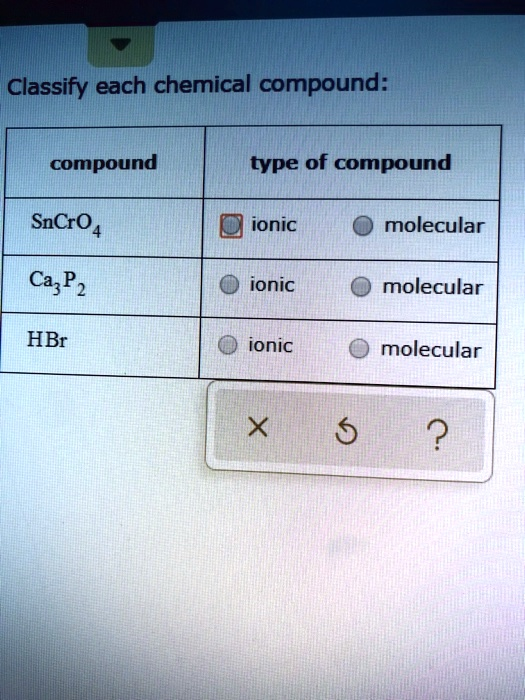Classify each chemical compound: compound type of compound SnCrO4 ionic molecular Ca
P
ionic molecular HBr ionic molecular

The Correct Answer and Explanation is:
Here are the correct classifications for each compound:
- SnCrO₄ – Ionic compound
- Ca₃P₂ – Ionic compound
- HBr – Molecular compound
Explanation:
Chemical compounds are broadly classified as either ionic or molecular based on the types of elements that compose them and the bonding between those elements.
Ionic compounds are formed when electrons are transferred from one atom to another, typically between metals and nonmetals. This transfer creates positively charged ions (cations) and negatively charged ions (anions), which are held together by strong electrostatic forces. Metals, such as calcium or tin, tend to lose electrons and form cations, while nonmetals or polyatomic ions accept electrons to become anions.
In the case of SnCrO₄ (tin(II) chromate), tin is a metal and CrO₄²⁻ is a polyatomic ion (chromate). This pairing of a metal and a polyatomic ion forms an ionic compound. Likewise, Ca₃P₂ (calcium phosphide) consists of calcium, a metal, and phosphorus, a nonmetal. Here, calcium atoms lose electrons to become Ca²⁺ ions and phosphorus atoms gain electrons to become P³⁻ ions, forming an ionic lattice.
Molecular compounds, on the other hand, consist of nonmetals bonded together by sharing electrons. This results in covalent bonds. HBr (hydrogen bromide) is composed of hydrogen and bromine, both of which are nonmetals. These atoms share a pair of electrons in a covalent bond, so HBr is classified as a molecular compound.
Understanding whether a compound is ionic or molecular helps predict its properties, such as solubility, melting point, and electrical conductivity. Ionic compounds generally have high melting points and conduct electricity when dissolved in water, whereas molecular compounds usually have lower melting points and do not conduct electricity in solution.
